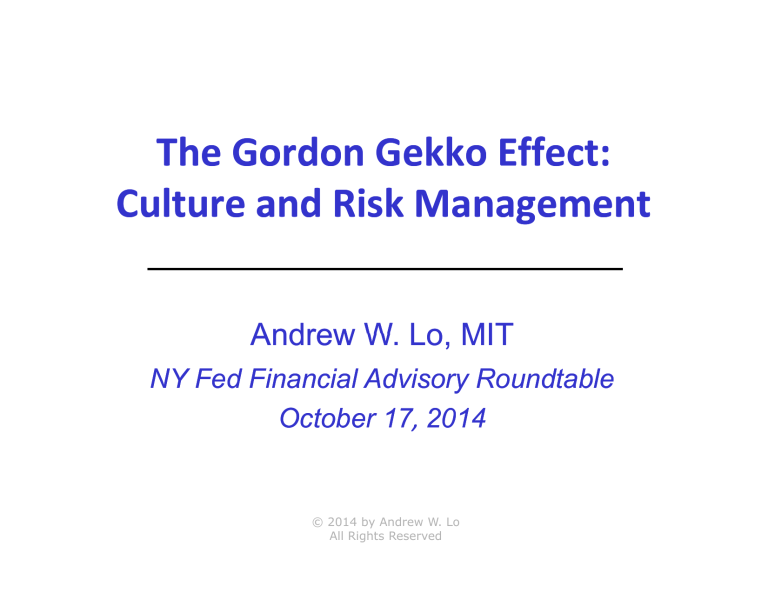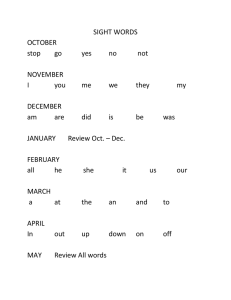
The Gordon Gekko Effect:
Culture and Risk Management
Andrew W
W. Lo,
Lo MIT
NY Fed Financial Advisory Roundtable
O b 17,
October
17
1 , 2014
© 2014 by Andrew W. Lo
All Rights Reserved
Motivation
FAR
“The point is, ladies and gentleman, that
greed, for lack of a better word, is
good Greed is right,
good.
right greed works
works.
Greed clarifies, cuts through, and
captures the essence of the
evolutionary
l
spirit. Greed,
d in allll off its
forms; greed for life, for money, for
love, knowledge
g has marked the
upward surge of mankind. And greed,
you mark my words, will not only save
Teldar Paper,
Paper but that other
malfunctioning corporation called the
USA.”
– Gordon Gekko
17 Oct 2014
© 2014 by Andrew W. Lo
All Rights Reserved
Slide 2
Motivation
FAR
What is culture?
Does it matter?
Can you change it?
Some examples
17 Oct 2014
© 2014 by Andrew W. Lo
All Rights Reserved
Slide 3
What Is Culture?
FAR
“Culture consists of patterns, explicit and implicit, of
and for behavior acquired and transmitted by
symbols,
b l constituting
tit ti th
the di
distinctive
ti ti achievements
hi
t off
human groups, including their embodiments in
artifacts” – Kroeber and Kluckhohn (1952)
artifacts
“Shared values… and norms” – O’Reilly and Chatman
(1996); “shared
shared basic assumptions… learned by a
group… taught to new members as the correct way” –
Schein (2004)
Common denominator: shared values and behavior
quantitative; bigg data is changing
g g this
Qualitative, not q
17 Oct 2014
© 2014 by Andrew W. Lo
All Rights Reserved
Slide 4
Does It Matter?
FAR
Yes:
Smith (1759, 1776), Mill (1843), Marx (1859), Weber
(1905): political economy
Hamilton (1964), Trivers (1971), Wilson (1975): kin
selection,
l
altruism,
l
reciprocity, sociobiology
b l
Richerson and Boyd (2005): culture and human
evolution
l ti
Guiso, Sapienza and Zingales (JEP 2006, JF 2013):
strategic mortgage defaults,
defaults trust and growth
Young (2014): social norms; Gordon and DiTomaso
(1992) Sørensen (2002): consistency and performance
(1992),
17 Oct 2014
© 2014 by Andrew W. Lo
All Rights Reserved
Slide 5
Can You Change It?
FAR
Culture Explained More By Biology Than Physics
Culture is a social phenomenon
Values are transmitted from person to person
Analogous to epidemiology
– Gordon Gekko = Patient Zero of “Greed is good”?
Psychology drives it (risk perception, group dynamics)
Three factors contribute to its transmission:
1. Top down: source of corporate values (leadership, authority)
2. Bottom up: composition of corporate population
3. Environment: some values will transmit more easily in different
environments than others (risk,
(risk regulation)
17 Oct 2014
© 2014 by Andrew W. Lo
All Rights Reserved
Slide 6
Top Down: Authority and Culture
FAR
Financial Incentives Unnecessary To Defer To Authority
Max Weber: different types of authority (charismatic,
traditional, legal‐rational)
Nuremburg trials of Nazi war crimes: “following orders”
Milgram experiment (1961): “Obedience to Authority”
– Volunteers will administer dangerous electric shocks
Zimbardo experiment (1971): “Lucifer Effect”
– Volunteers will physically and mentally abuse others
Authority often supersedes volunteer moral judgment
– Minimal financial incentive needed
17 Oct 2014
© 2014 by Andrew W. Lo
All Rights Reserved
Slide 7
Bottom Up: Composition and Culture
FAR
Selection Bias Can Influence/Create Culture
Corporations select specific types of employees
Ho (2009): 1990s Wall Street sought Ivy League “best
and brightest”
– Rationalized Wall Street negatives to fit elite self‐image
Lyng (1990): Shared “edgework” creates shared values
– Risky work creates group sense of elitehood; gallows humor
Quants bring their own culture (physics, math, CS, etc.)
Demographic shifts can change corporate culture
– Population dynamics: replacement, promotion, expansion
17 Oct 2014
© 2014 by Andrew W. Lo
All Rights Reserved
Slide 8
Environment and Culture
FAR
Many Aspects of the Environment
Competition, hierarchy, business conditions, regulatory
climate, etc.
Douglas and Wildavsky (1982): risk priorities reflect
cultural
l
l values;
l
prioritizing riskk is how
h the
h culture
l
“
“sees”
”
its environment (insurance vs. finance)
An
A iimportant
t t environmental
i
t l condition
diti is
i the
th
importance of the culture
– Corporate culture rejects,
rejects ignores opposing values; even
constant criticism can be tamed by culture (Weeks 2004)
Corporate
p
culture applies
pp
to regulators
g
too!
17 Oct 2014
© 2014 by Andrew W. Lo
All Rights Reserved
Slide 9
Illustrative Examples
FAR
Case 1: Long‐Term Capital Management
LTCM’s culture consistent with experimental financial
engineering firm; collapse a “normal accident”
However, LTCM’s creditors saw LTCM as nearly riskfree
– Virtually no “haircut” on loans to LTCM; ““We had no idea
they would have trouble—these people were known for risk
management. They had taught it; they designed it
it” (D. Napoli,
Merrill Lynch)
– LTCM exemplified shared Wall Street elite values of
intelligence,
ll
ambition,
b
success
Shared failure among the LTCM creditor culture?
17 Oct 2014
© 2014 by Andrew W. Lo
All Rights Reserved
Slide 10
Illustrative Examples
FAR
Case 2: AIG Financial Products
CEO Greenberg uses personal risk management style
to build AIG into insurance powerhouse
2004: AIGFP sells first CDS on CDOs under Cassano
2005: Greenberg ousted, AIG risk culture on autopilot
2006: AIGFP stops sales of CDS
Cassano defends CDS risk analysis until his ouster in
February 2008
Overconfidence in AIG’s risk management culture led
to several balance sheet time bombs
17 Oct 2014
© 2014 by Andrew W. Lo
All Rights Reserved
Slide 11
Illustrative Examples
FAR
Case 3: Lehman Brothers and Repo 105
Repo 105: accounting trick adopted by Lehman Bros.
Kept secret from board, SEC, outside disclosure
counsel
“Shopped” British law firm, outside auditors
Global financial controller warned of reputational risk,
two chief financial officers ignored warnings
Story pieced together in bankruptcy court
Corporate culture saw risk of disclosure as more
important than other financial risks
17 Oct 2014
© 2014 by Andrew W. Lo
All Rights Reserved
Slide 12
Illustrative Examples
FAR
Case 4: Rogue Traders and Société Générale
Jérôme Kerviel built up a €49 billion long position;
SocGen’s total capital was €26 billion at the time
Kerviel’s activities were missed by four levels of
management for
f over a year
A culture of neglect in investment bank division
– For historical reasons, SocGen elites preferred retail division
– Investment bank a mere “cash machine”
K
Kerviel
i l caught
ht by
b single
i l monitor
it in
i SocGen
S G Basel
B l
compliance
17 Oct 2014
© 2014 by Andrew W. Lo
All Rights Reserved
Slide 13
Illustrative Examples
FAR
Case 5: The SEC and Bernie Madoff
Six “red flag” complaints from 1992‐2008 (OIG 2009)
Two examinations unaware of each others’ existence!
Earlier negative results biased the SEC against credible
subsequent complaints
SEC: hierarchical, low morale, risk‐averse (GAO 2013)
– “managers have been afraid to close cases or make
decisions because senior officers want to minimize the
chances that they would be criticized later
later.” – anonymous
SEC respondent
– Criticism strikes against legitimacy, “legal‐rational” authority
Untitled Lecture
© 2014 by Andrew W. Lo
All Rights Reserved
Slide 14
How To Combat the Gekko Effect?
FAR
Zimbardo (2007): “Resist situational influences”; easier
said than done!
A Modest Proposal:
Recognize that culture exists and it matters
Explicitly define the ideal culture for your organization
Institutionalize mechanisms for shaping culture:
– Invite and facilitate constructive debate (“red team”)
– Engineer diversity while preserving cultural identity
– Instill clear values: honesty,
y, responsibility,
p
y, admittingg mistakes,,
refusing unjust authority, etc.
– Create metrics, feedback loops, and reinforcement learning,
i e NTSB
i.e.,
17 Oct 2014
© 2014 by Andrew W. Lo
All Rights Reserved
Slide 15
Additional References
FAR
Douglas, Mary, and Aaron Wildavsky. 1982. Risk and culture: an essay on the selection of technological and
environmental dangers. Berkeley: University of California Press.
Fielding, Eric, Andrew W. Lo, and Jian Helen Yang. 2011. “The National Transportation Safety Board: A Model for
Systemic Risk Management.” Journal of Investment Management 9, 17‐49.
General Accounting Office.
Office 1999.
1999 “Long‐Term
Long‐Term Capital Management: Regulators Need to Focus Greater Attention
on Systemic Risk.” GAO/GGD‐00‐3. October. Washington, D.C.: Government Printing Office.
Government Accountability Office. 2013. “Securities and Exchange Commission: Improving Personnel
Management Is Critical for Agency's Effectiveness.” GAO‐13‐621. July. Washington, D.C.: Government Printing
Office.
Gordon,
G d
G
George G
G. and
d Nancy
N
DiTomaso.
DiT
1992 “Predicting
1992.
“P di ti corporate
t performance
f
ffrom organizational
i ti
l culture.”
lt
”
Journal of Management Studies 29, 783‐798.
Guiso, Luigi, Paola Sapienza and Luigi Zingales. 2013. “The Determinants of Attitudes toward Strategic Default on
Mortgages.” The Journal of Finance 58, 1473‐1515.
q
an ethnography
g p y of Wall Street. Durham: Duke Universityy Press.
Ho, Karen Zouwen. 2009. Liquidated:
Hunter, Mark and N. Craig Smith. 2011. “Société Générale: The Rogue Trader.” INSEAD Case #711‐006‐1. INSEAD
Social Innovation Centre.
Kroeber, Alfred Louis and Clyde Kluckhohn. 1952. Culture: a critical review of concepts and definitions.
Cambridge, Mass: Peabody Museum of American Archaeology.
Lyng,
L
St
Stephen.
h
1990 “Edgework:
1990.
“Ed
k A Social
S i l Psychological
P h l i l Analysis
A l i off Voluntary
V l t
Ri
Riskk TTaking.”
ki ” Th
The A
American
i
JJournall
of Sociology 95, 851‐886.
Milgram, Stanley. 1963 “Behavioral Study of Obedience.” The Journal of Abnormal and Social Psychology 67,
371‐378.
17 Oct 2014
© 2014 by Andrew W. Lo
All Rights Reserved
Slide 16
Additional References
FAR
O'Reilly, Charles A. and Jennifer Chatman. 1996. “Culture as social control: Corporations, culture, and
commitment.” In B. M. Staw and L.L. Cummings, editors, Research in Organizational Behavior 18, 157‐200.
Greenwich, Conn.: JAI Press.
Perrow, Charles. 1999. Normal accidents: living with high‐risk technologies. Princeton, N.J.: Princeton University
Press.
Schein, Edgar H. 2004. Organizational culture and leadership. San Francisco: Jossey‐Bass.
Securities and Exchange Commission, Office of Investigations. 2009. Investigation of Failure of the Securities and
Exchange Commission To Uncover Bernard Madoff's Ponzi Scheme, Public Version. Report No. OIG‐509. August
31. Washington, D.C.: Government Printing Office.
Shapira,
Sh i Zur.
Z 1995.
1995 Risk
Ri k taking:
t ki
a managerial
i l perspective.
ti New
N York:
Y k Russell
R
ll Sage
S
Foundation.
F
d ti
Shelp, Ronald Kent, and Al Ehrbar. 2009. Fallen giant: the amazing story of Hank Greenberg and the history of
AIG. Second edition. Hoboken, N.J.: Wiley.
Smith, Charles W. 2005. “Financial edgework: Trading in market currents.” In Edgework: The Sociology of Risk
g edited byy Stephen
p
Lyng,
y g 187–200. London: Routledge.
g
Taking,
Société Générale. 2008. “Mission Green: Summary Report.” May 20. English translation. Accessed September 20,
2014.
https://www.societegenerale.com/sites/default/files/12%20May%202008%20The%20report%20by%20the%20
General%20Inspection%20of%20Societe%20Generale.pdf
The strength of corporate culture and the reliability of firm performance.
performance.”
Sørensen, Jesper B. 2002. “The
Administrative Science Quarterly 47, 70‐91.
Sterngold, James. 1987. “Boesky Sentenced To 3 Years In Jail In Insider Scandal.” New York Times. December 19.
Valukas, Anton R. 2010. “Report Of Anton R. Valukas, Examiner: Chapter 11, Case No. 08‐13555 (JMP), In Re
Lehman Brothers Holdings Inc., Et Al, Debtors.” Volume 3. March 11. United States Bankruptcy Court, Southern
District Of New York
York. Accessed September 23
23, 2014
2014. http://jenner
http://jenner.com/lehman/VOLUME%203.pdf
com/lehman/VOLUME%203 pdf
17 Oct 2014
© 2014 by Andrew W. Lo
All Rights Reserved
Slide 17
Additional References
FAR
Venkatesh, Sudhir Alladi. 2006. Off the books: the underground economy of the urban poor. Cambridge, Mass:
Harvard University Press.
Weeks, John. 2004. Unpopular culture: the ritual of complaint in a British bank. Chicago: University of Chicago
Press.
Weiser,
Weiser Stanley.
Stanley 2008.
2008 “Repeat
Repeat After Me: Greed Is Not Good.
Good ” Los Angeles Times
Times. October 5.
5
Wilson, Margo and Martin Daly. 1985. “Competitiveness, risk taking, and violence: the young male syndrome.”
Ethology and Sociobiology 6, 59‐73.
Zimbardo, Philip G. 2007. The Lucifer effect: understanding how good people turn evil. New York: Random
House.
17 Oct 2014
© 2014 by Andrew W. Lo
All Rights Reserved
Slide 18



